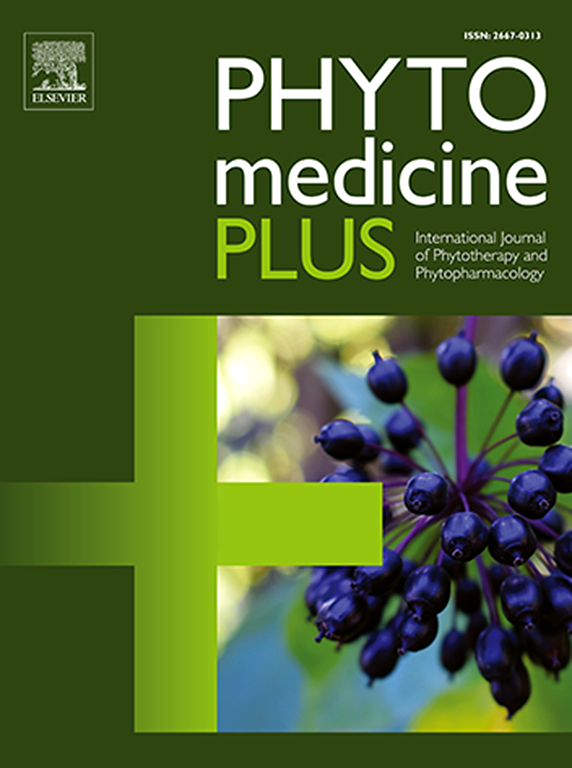Exploring ethnomedicinal uses and relevance to phytochemical profile, pharmacological activities, and tissue culture of Tecoma stans (L.) Juss. ex Kunth
Q3 Pharmacology, Toxicology and Pharmaceutics
引用次数: 0
Abstract
Ethnopharmacological relevance
Tecoma stans (L.) Juss. ex Kunth (Bignoniaceae) is a flowering plant native to the Americas and widely naturalized in tropical and subtropical regions. It has been traditionally used to treat diabetes, arthritis, and urinary disorders, with additional benefits including anti-inflammatory, antimicrobial, and antioxidant properties.
Aim
Our review provides a comprehensive overview on the therapeutic potential of Tecoma stans focusing on its anti-diabetic properties, traditional ethnomedicinal uses, pharmacological activities, mechanisms of action of its key phytochemicals, and the comparison of these findings with results from plant tissue culture studies. Furthermore, the review explores the applications of Tecoma in green biotechnology and tissue culture, emphasizing conservation and sustainable production of bioactive compounds.
Methodology
The literature on Tecoma stans was sourced from Google Scholar, PubMed, and ScienceDirect search engines, covering publications from the first report on the topic in 1954 until April 2024. The review focused on studies highlighting the ethnomedicinal uses, pharmacological activities, phytochemical composition, tissue culture, isolated endophytic fungi and relevant preclinical studies. Particular emphasis was placed on delineating the molecular mechanisms of action of isolated bioactive compounds and systematically evaluating the potential biotechnological applications of the plant, with a focus on sustainable production methodologies.
Results
Several studies have demonstrated the efficacy of Tecoma stans in managing diabetes, with evidence suggesting that its therapeutic effectiveness is comparable to that of established conventional treatments. Key phytochemicals such as tecostanine, tecomine, anthranilic acid, and gallic acid have been linked to hypoglycemic, anti-inflammatory, antioxidant, and antimicrobial activities. Mechanistic insights suggest that these compounds modulate various biological targets involved in glycemic control and inflammation. While these compounds have shown promising activity against several biological targets, further clinical trials are necessary to fully validate these effects. Preclinical studies indicate low toxicity; however, comprehensive toxicity assessments are still needed to confirm safety for clinical use. Additionally, tissue culture approaches and isolated endophytes have been investigated as sustainable methods for the production of these bioactive secondary metabolites.
Conclusions
In summary, the phytochemicals derived from Tecoma stans exhibit significant therapeutic potential, particularly in the management of diabetes and related conditions, without notable side effects. These findings suggest that Tecoma stans could be considered a viable alternative to conventional treatments for diabetes and other ailments. Furthermore, advancements in green biotechnology, plant tissue culture techniques and endophytes isolation and identification offer promising avenues for large-scale production and conservation, warranting further exploration and potential integration into clinical practice.

探索民族医学用途及其与Tecoma stans (L.)的植物化学特征、药理活性和组织培养的相关性汁液。前肯
民族药理学相关性:tecoma stans (L.)汁液。大戟属植物是一种开花植物,原产于美洲,在热带和亚热带地区广泛种植。传统上,它被用于治疗糖尿病、关节炎和泌尿系统疾病,还具有抗炎、抗菌和抗氧化等额外的好处。本文综述了Tecoma stans的治疗潜力,重点介绍了其抗糖尿病特性、传统民族医学用途、药理活性、主要植物化学物质的作用机制,并将这些发现与植物组织培养研究结果进行了比较。此外,综述了Tecoma在绿色生物技术和组织培养中的应用,强调了生物活性化合物的保护和可持续生产。关于Tecoma stan的文献来源于b谷歌Scholar、PubMed和ScienceDirect搜索引擎,涵盖了从1954年第一份关于该主题的报告到2024年4月的出版物。综述重点介绍了其民族医药用途、药理活性、植物化学成分、组织培养、分离内生真菌和相关临床前研究。特别强调描述分离的生物活性化合物的分子作用机制和系统地评价该植物潜在的生物技术应用,重点是可持续生产方法。结果几项研究证明了Tecoma stans治疗糖尿病的有效性,有证据表明其治疗效果可与现有的常规治疗相媲美。关键的植物化学物质如莨菪碱、莨菪碱、邻氨基苯酸和没食子酸具有降血糖、抗炎、抗氧化和抗菌活性。机制见解表明,这些化合物调节涉及血糖控制和炎症的各种生物靶点。虽然这些化合物已经显示出对几种生物靶点的有希望的活性,但需要进一步的临床试验来充分验证这些效果。临床前研究表明低毒性;然而,仍需要进行全面的毒性评估,以确认临床使用的安全性。此外,已经研究了组织培养方法和分离的内生菌作为生产这些生物活性次生代谢物的可持续方法。综上所述,从Tecoma stans中提取的植物化学物质具有显著的治疗潜力,特别是在糖尿病和相关疾病的治疗中,且无明显的副作用。这些发现表明,Tecoma支架可以被认为是糖尿病和其他疾病常规治疗的可行替代方案。此外,绿色生物技术、植物组织培养技术和内生菌分离鉴定的进步为大规模生产和保护提供了有希望的途径,值得进一步探索和潜在的临床应用。
本文章由计算机程序翻译,如有差异,请以英文原文为准。
求助全文
约1分钟内获得全文
求助全文
来源期刊

Phytomedicine Plus
Medicine-Complementary and Alternative Medicine
CiteScore
3.70
自引率
0.00%
发文量
178
审稿时长
81 days
期刊介绍:
 求助内容:
求助内容: 应助结果提醒方式:
应助结果提醒方式:


